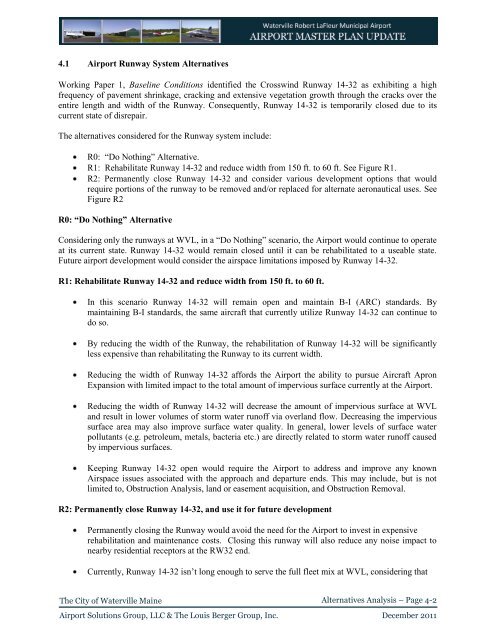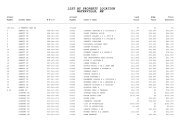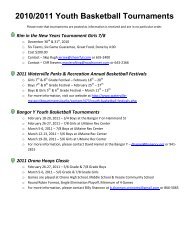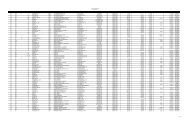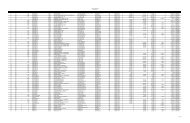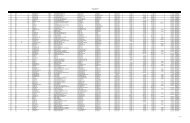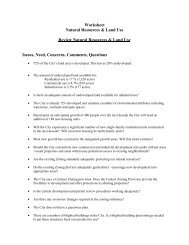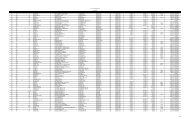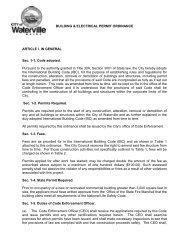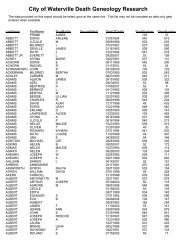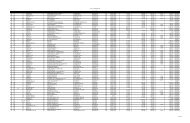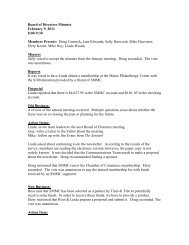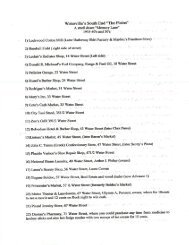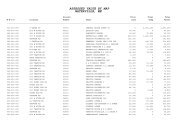Airport Master Plan 2012 - City of Waterville
Airport Master Plan 2012 - City of Waterville
Airport Master Plan 2012 - City of Waterville
You also want an ePaper? Increase the reach of your titles
YUMPU automatically turns print PDFs into web optimized ePapers that Google loves.
4.1 <strong>Airport</strong> Runway System Alternatives<br />
Working Paper 1, Baseline Conditions identified the Crosswind Runway 14-32 as exhibiting a high<br />
frequency <strong>of</strong> pavement shrinkage, cracking and extensive vegetation growth through the cracks over the<br />
entire length and width <strong>of</strong> the Runway. Consequently, Runway 14-32 is temporarily closed due to its<br />
current state <strong>of</strong> disrepair.<br />
The alternatives considered for the Runway system include:<br />
R0: “Do Nothing” Alternative.<br />
R1: Rehabilitate Runway 14-32 and reduce width from 150 ft. to 60 ft. See Figure R1.<br />
R2: Permanently close Runway 14-32 and consider various development options that would<br />
require portions <strong>of</strong> the runway to be removed and/or replaced for alternate aeronautical uses. See<br />
Figure R2<br />
R0: “Do Nothing” Alternative<br />
Considering only the runways at WVL, in a “Do Nothing” scenario, the <strong>Airport</strong> would continue to operate<br />
at its current state. Runway 14-32 would remain closed until it can be rehabilitated to a useable state.<br />
Future airport development would consider the airspace limitations imposed by Runway 14-32.<br />
R1: Rehabilitate Runway 14-32 and reduce width from 150 ft. to 60 ft.<br />
In this scenario Runway 14-32 will remain open and maintain B-I (ARC) standards. By<br />
maintaining B-I standards, the same aircraft that currently utilize Runway 14-32 can continue to<br />
do so.<br />
By reducing the width <strong>of</strong> the Runway, the rehabilitation <strong>of</strong> Runway 14-32 will be significantly<br />
less expensive than rehabilitating the Runway to its current width.<br />
Reducing the width <strong>of</strong> Runway 14-32 affords the <strong>Airport</strong> the ability to pursue Aircraft Apron<br />
Expansion with limited impact to the total amount <strong>of</strong> impervious surface currently at the <strong>Airport</strong>.<br />
Reducing the width <strong>of</strong> Runway 14-32 will decrease the amount <strong>of</strong> impervious surface at WVL<br />
and result in lower volumes <strong>of</strong> storm water run<strong>of</strong>f via overland flow. Decreasing the impervious<br />
surface area may also improve surface water quality. In general, lower levels <strong>of</strong> surface water<br />
pollutants (e.g. petroleum, metals, bacteria etc.) are directly related to storm water run<strong>of</strong>f caused<br />
by impervious surfaces.<br />
Keeping Runway 14-32 open would require the <strong>Airport</strong> to address and improve any known<br />
Airspace issues associated with the approach and departure ends. This may include, but is not<br />
limited to, Obstruction Analysis, land or easement acquisition, and Obstruction Removal.<br />
R2: Permanently close Runway 14-32, and use it for future development<br />
Permanently closing the Runway would avoid the need for the <strong>Airport</strong> to invest in expensive<br />
rehabilitation and maintenance costs. Closing this runway will also reduce any noise impact to<br />
nearby residential receptors at the RW32 end.<br />
Currently, Runway 14-32 isn‟t long enough to serve the full fleet mix at WVL, considering that<br />
The <strong>City</strong> <strong>of</strong> <strong>Waterville</strong> Maine<br />
Alternatives Analysis – Page 4-2<br />
<strong>Airport</strong> Solutions Group, LLC & The Louis Berger Group, Inc. December 2011


